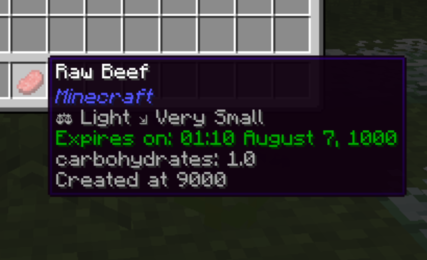Food
Food is what you need to survive.
| ToDo: Something is missing! Help fill out the following missing information:
Make template for food
|
| This page/section was imported/copied from the TFC-Classic Wiki! The information provided by this page/section was imported/copied from the Classic wiki and is likely outdated, missing information and not up to standards. Do not use it as a reliable source of information, if you can improve it please feel free to improve it!
|
Contents
Categories
There are five different categories of food: Fruit, Vegetable, Grain, Protein, and Dairy. These effect Nutrition.
| Fruit | Vegetable | Grain* | Protein** |
|---|---|---|---|
| Banana | Beet | Barley | Beef |
| Blackberry | Cabbage | Maize | Pork |
| Blueberry | Carrot | Oat | Chicken |
| Bunchberry | Garlic | Rice | Mutton |
| Cherry | Green Bean | Rye | Fish |
| Cloudberry | Green Bell Pepper | Wheat | Bear |
| Cranberry | Onion | Calamari | |
| Elderberry | Potato | Horse meat | |
| Gooseberry | Red Bell Pepper | Pheasant | |
| Green Apple | Seaweed | Venison | |
| Lemon | Soybean**** | Wolf | |
| Olive | Squash | Rabbit | |
| Orange | Tomato*** | Hyena | |
| Peach | Yellow Bell Pepper | Duck | |
| Plum | Chevon | ||
| Raspberry | Gran Feline | ||
| Red Apple | Camelidae | ||
| Snow Berry | Soybean**** | ||
| Strawberry | |||
| Wintergreen Berry |
- * Grains have dough, grain, and bread versions.
- ** Meat has cooked versions.
- *** Tomatoes are considered vegetables for nutrition reasons.
- **** Soybeans are both protein and vegetables.
Decay
Food comes with an expiration date in TFC, based on when the food item was created. Crafting together food items to stack them, giving the soonest expiration date. Alternatively, you could use a hotkey (configurable, default X) over any food stack in inventory to stack there as many stacks of same food from your inventory and open container as possible. Note, that both hotkey and recipe only works for food with same traits. Different foods decay at different rates. For example, Fruit decays rather quickly, around two weeks, whereas cooked and salted meat can last for months. Preserving food can extend its life greatly.
Preservation
There are many different ways to preserve food and change the rate at which it decays. Each method results in a decay modifier, meaning that if two methods stack together, the resulting effect on the decay is a multiplier equal to the two method modifiers multiplied together. When multiplying these two numbers together, it results in a smaller number, meaning that the food will decay slower. The majority of preservation methods can be used in combination to stack the modifiers. The combination of pickling and salting, and the combination of cooking and drying are the only two combinations of directly altering food that will not stack multipliers when used. Storage decay modifiers such as the ceramic vessel obviously cannot be used in combination with other storage decay modifiers such as storing in a barrel of vinegar.
Cooking
All foods can be cooked in either a firepit, forge, or grill. Bread will burn and be destroyed if overheated, which can happen if left unattended in a forge or on grill; other foods cannot. While all three cooking methods yield cooked food with the same nutritional value, food cooked on a grill will keep the longest before decaying, then food cooked in a firepit, while food cooked on a forge will decay the soonest.
Salt
- Main article: Salt
Salt is used to extend the shelf life of meat.
Pickling
- Main article: Pickling
All foods except those in the grain category can be pickled. Pickled raw food has a pickled decay modifier of 0.5, while pickled cooked food has a pickled decay modifier of 0.75. As long as pickled food is sealed within a barrel of vinegar, it has an additional decay modifier of 0.1.
Grain Refining
For cereal crops, the harvest must first be refined by crafting it with a knife to get grains. These refined grains have a much slower decay rate than all other stages of cereal crops (Harvest, Flour, Dough, Bread).
